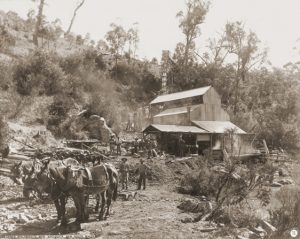
Nineteenth-century Australian pamphlets
Work to discover the Royal Commonwealth Society department’s collection of rare nineteenth-century pamphlets has focused recently upon Australia. We are delighted to announce that more than 250 new titles have been added to the library’s on-line iDiscover catalogue. Few other British libraries hold copies of many of these pamphlets, which were published in New South Wales, Victoria, Queensland, Tasmania, South Australia and Western Australia, and therefore were not acquired under the UK legal deposit scheme. This blog features complementary photographs from the RCS’s significant collection of early Australian photographs to illustrate the pamphlets’ themes.
There is little opportunity here to do justice to the pamphlets’ diverse themes, or to emphasise their potential contributions to historical research, but a number of significant subjects are readily apparent. Chronologically, the pamphlets date from 1880 to 1900, and offer important insight into a formative period of Australia’s growth and development. The Commonwealth of Australia was created in 1901 through the union of the six colonies, and many pamphlets reflect the intense political discussions which preceded the birth of the new nation. Leading politicians, political theorists, journalists and academics in Britain and Australia debated the creation of a new federal constitution and political and judicial institutions. Many looked to the recent Confederation of Canada in 1867 as a model. Authors also considered future relations with Britain and the rest of the Empire, and Australia’s responsibility for its own defence. The economy and finances of the new country inspired a number of works, which weighed the merits of a protectionist or a free trade policy.
Pamphlets reflected the resource-based, agricultural nature of Australia’s economy and encouraged the growth of existing industries and the development of manufacturing. There are works on sheep and the wool industry, dairy and cattle ranching, and novel plans to develop a trade in frozen meat for export. Investment was invited in fruit farming and the production of sugar in Queensland. Accounts of the gold rushes in South Australia, Western Australia and the Northern Territory from the 1870s lured prospectors to the gold fields with reports of spectacular finds, while mining companies commissioned specialist geological studies. A strong theme among writers about labour and the economy was the need to defend workers’ rights to fair pay and safe working conditions, to be enforced by strike action if necessary. Others commented upon the treatment of labourers recruited from South Asia, China and Oceania.
Recognising that people would be its greatest resource, authors encouraged emigration to Australia to accelerate economic, social and political development. Writers sought to define a national identity and to promote arts and culture, including a contribution on the Australian literary scene by leading novelist Rosa Campbell Prae (1851-1935). Other women writers such as Jeannie Lockett (1847–1890) championed the rights of women. The pamphlets include works about Australia’s Aboriginal peoples, commenting upon their relations with government and exploring their languages and culture.
The late nineteenth-century witnessed significant developments in transportation and communication to more closely connect Australia’s colonies to each other and to the wider world. Pamphlets report upon major railway construction projects during the 1880s which linked colonial railways into a wider network, and the growth of government steamboat services.
Access to the telegraph was of intense interest, and Australia was first connected to the outside world in 1872 via a submarine cable at Darwin. The pamphlets display a keen interest in scientific progress, including geographical exploration; geology and the impact of volcanic activity; climate, weather and ocean currents; water resources and artesian basins; and Australia’s unique animal and bird life. Advances in medicine and demand for public health initiatives were reflected in a number of pamphlets. Many medical and scientific writers published their findings in the Australasian Association for the Advancement of Science.
All of these pamphlets can be searched for on iDiscover using thematic and geographical keywords, or Library of Congress subject headings. Visit Cambridge Digital Library to view more stunning Australian photographs.
The featured image is Scrub fire, Penong, South Australia, 1910, Y3011DDD(LS)/102.






